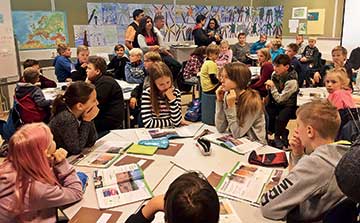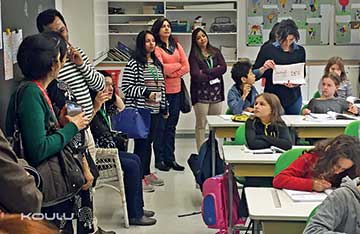Anju Dhawan
I have always been simultaneously an educator and learner. My quest for learning keeps me inquisitive and takes me to different places. Having heard so much about the Finnish education system I decided to go to Finland for a study tour. I landed in Helsiniki for an innovation camp for educational professionals, ‘Finland Phenomenon – inside the world’s most successful education system’.
Finland has a high level of educational achievement and it is one of the world’s most literate societies. Education has always been an integral part of the Finnish culture and society. Finland’s history is a history of the progress of education. About 99 percent of the Finnish citizens complete basic compulsory education and 94 percent go on to upper secondary school graduate programs.
 Schools have played an important role in transforming Finland from a traditional industrial nation to a modern innovation based knowledge economy.
Schools have played an important role in transforming Finland from a traditional industrial nation to a modern innovation based knowledge economy.
The Finland education system focuses not on marks or grades but on honesty, happiness and producing responsible citizens. The Finnish are pioneers in promoting social equality – they have a unified education system for the rich and poor. They have compulsory and free basic education for all funded by their government. Basic education starts at the age of seven. All through their basic education, from age 7 till 13, all children are encouraged to become ‘individual learners’. The student-teacher ratio is 2:20 in each class. There are no exams, only informal tests. All students have to take a matriculation exam at the age of 16 which is the only one national exam. Schools are learning communities where everyone is an active learner.
During our stay we visited six schools in Helsinki, Espoo and Turku. The one thing we noticed in all schools we visited was a lot of flexibility and innovation in teaching and learning. For example, a class one child can go sit in a class two math class if he/she wishes to. Two teachers of two different classes combine classes and do new things in collaboration. The children can decide what project they want to do,how they want to do it and how they want to be evaluated. Within a class also each child can decide what he/she wants to do. There is flexibility even after their matriculation exam. The students can choose to join a vocational school, university, or the army. They can go to a vocational school and then a university and vice versa. There are no rules to education – choose your own path is the key. Also, there are no dead-ends in the education system and it is a continuous process. The children look very relaxed and happy.
Now let’s talk about the Finnish teachers who are the backbone of this system. The teachers are given broad general guidelines on curriculum by the education board but how they want to implement it, the methodology,pedagogy and planning is entirely their own decision. They can develop the curriculum and content themselves. The teachers are given autonomy in what they do. All they have to do is create new and interesting learning environments. They are highly educated, passionate and respected like doctors, lawyers or any other professionals. Instead of comparing or rating children, they focus on supporting and guiding them. Most importantly no private tutoring is allowed. The teachers go through an extensive teacher training program at university. Particular attention is given to building pedagogical thinking skills that enable teachers to manage the teaching process in accordance with contemporary knowledge and practice. The teaching is based on research.
ICT is an integral part of Finnish schools (even small countryside schools). Their ICT infrastructure is one of the best in the world. ICT is integrated as a tool across the curriculum and not as a separate subject. ipads and other gadgets are used as normal tools but have not replaced pen and paper. The use of ICT offers students a means to voice their thoughts and ideas in various ways which develops thinking and learning skills. All teachers use ICT extensively in their teaching and some of them create their own e-books and curriculum to save the cost of expensive printed books.
 Some classes and subjects are worth mentioning. The home economics class is one such class in which children are taught basic household chores like cooking, laundry, cleaning, washing utensils and making budgets to run homes. They believe in preparing everyone for life. They also believe that everyone is capable of doing everything. Another class is World Religion in which students receive knowledge about all religions and holy books. Students are taught to respect all religions and to be good human beings. The carpentry and metallurgy classes were also impressive.
Some classes and subjects are worth mentioning. The home economics class is one such class in which children are taught basic household chores like cooking, laundry, cleaning, washing utensils and making budgets to run homes. They believe in preparing everyone for life. They also believe that everyone is capable of doing everything. Another class is World Religion in which students receive knowledge about all religions and holy books. Students are taught to respect all religions and to be good human beings. The carpentry and metallurgy classes were also impressive.
We saw students making chess boards, boats, machines and many other things in these classes. Most of these classes are compulsory for at least one year(class seven) and then the children can decide whether they want to continue learning these skills or not.
The infrastructure in most schools was simple yet well-planned. The seating arrangements were casual and varied across classrooms. Some classrooms had relaxed and casual spaces where students could rest or engage in activities differently. The Finnish believe that it is important to have innovative, versatile learning spaces where students can learn individually or in groups. They believe in creating new and innovative environments. Almost all schools had separate spaces for disabled children where their therapies could be done. Most schools were in the lap of nature and we saw some children going to forests and rivers to do their projects. Nature is an integral part of their schools and life in general. The Finnish people like to have a clean and green environment.
The Finnish did not achieve their success because they have great infrastructure or facilities, but because of their dedication and honest implementation of their ideas. The beauty of the Finnish education system lies in its simplicity.
The secrets of the success of the Finnish education system are:
- Children start school at the age of 7
- Lots of free time (15 minutes pause for play after every 45 minutes of study)
- Emphasis on collaboration, problem-solving and critical thinking
- Special programs for children with special needs
- Highly permeable system, no dead ends, focus on progression
- Focus on learning rather than testing
- 100 percent state funded, yet schools given most of the responsibility
- World class teacher training
- Inclusiveness, accessibility, flexibility, quality, trust and equity as driving principles
The author is a passionate educator. She has taught in public schools for 3 years. She founded SMS Consultants in 2003, a company that provides professional consulting services to schools. She is also the president of an NGO named Sashakt. Sashakt works towards the education and empowerment of under privileged and specially-abled children. She can be reached at info@smsconsultants.org.
